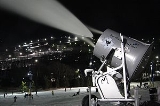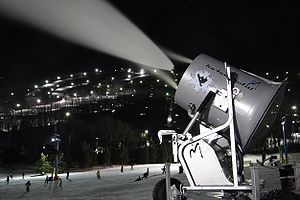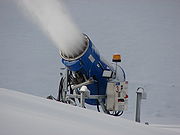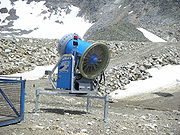
Snowmaking
Encyclopedia


Ski resort
A ski resort is a resort developed for skiing and other winter sports. In Europe a ski resort is a town or village in a ski area - a mountainous area, where there are ski trails and supporting services such as hotels and other accommodation, restaurants, equipment rental and a ski lift system...
s to supplement natural snow. This allows ski resorts to improve the reliability of their snow cover and to extend their ski seasons. Indoor ski slope
Indoor ski slope
Indoor ski slopes are found in several countries, proving a climate controlled environment can be maintained in which snow can be manufactured using a snow cannon, enabling skiing and snowboarding to take place year-round.-Notable mentions:...
s often use snowmaking. They are generally able to do so all year round as they have a climate-controlled environment.
The production of snow requires low temperatures. The threshold temperature for snowmaking increases as humidity decreases. Wet bulb temperature is used as a metric since it takes air temperature and relative humidity into account. Snowmaking is a relatively expensive process in its energy use; thereby limiting its use.
History

Grossinger's Catskill Resort Hotel
Grossinger's Catskill Resort Hotel was a resort in the Catskill Mountains in the Town of Liberty, near the village of Liberty, New York. It is part of the Borscht Belt. After decades of activity and notable guests, it closed its doors in 1986.-History:...
earned a place in the history of skiing as the first in the world to use artificial snow. Snowmaking started to be used on a commercial scale in the early 1970s. Since then, many ski resorts have come to depend on snowmaking.
Snowmaking has become increasingly complex, so as to achieve greater efficiency. Traditionally snowmaking relied on having a skilled snowmaker to operate the equipment. The addition of computer control means that snow making can be controlled with greater precision to ensure that snow guns only operate when conditions make snowmaking possible. However, the process is not fully automatic as computers only supplement human control. Recently, all weather snowmakers have been developed by IDE.
Operation

Snowmaking plants require water pumps and air compressor
Air compressor
An air compressor is a device that converts power into kinetic energy by compressing and pressurizing air, which, on command, can be released in quick bursts...
s that are both very large and expensive. The production itself requires large amounts of energy. It takes about 200,000 US gallons (757kL) of water to cover an acre to a depth of 1 foot (0.3048 m).
Snowmaking begins with a water supply such as a river or reservoir. Water is pushed up a pipeline on the mountain using very large electric pumps in a pump house. This water is distributed through an intricate series of valves and pipes to any trails that require snowmaking. Many resorts also add a nucleating
Nucleation
Nucleation is the extremely localized budding of a distinct thermodynamic phase. Some examples of phases that may form by way of nucleation in liquids are gaseous bubbles, crystals or glassy regions. Creation of liquid droplets in saturated vapor is also characterized by nucleation...
agent to ensure that as much water as possible freezes and turns into snow. These products are organic or inorganic materials that facilitate the water molecules to form the proper shape to freeze into ice crystals
Ice crystals
Ice crystals are a small crystalline form of ice including hexagonal columns, hexagonal plates, dendritic crystals, and diamond dust. The highly symmetric shapes are due to depositional growth, namely, direct deposition of water vapour onto the ice crystal...
. The products are non-toxic and biodegradable.

Ice nucleation-active proteins
The water is sometimes mixed with ina (ice nucleation-active) proteinProtein
Proteins are biochemical compounds consisting of one or more polypeptides typically folded into a globular or fibrous form, facilitating a biological function. A polypeptide is a single linear polymer chain of amino acids bonded together by peptide bonds between the carboxyl and amino groups of...
s from the bacterium Pseudomonas syringae
Pseudomonas syringae
Pseudomonas syringae is a rod shaped, Gram-negative bacterium with polar flagella. It is a plant pathogen which can infect a wide range of plant species, and exists as over 50 different pathovars, all of which are available to legitimate researches via international culture collections such as the...
. These proteins serve as effective nuclei
Nucleation
Nucleation is the extremely localized budding of a distinct thermodynamic phase. Some examples of phases that may form by way of nucleation in liquids are gaseous bubbles, crystals or glassy regions. Creation of liquid droplets in saturated vapor is also characterized by nucleation...
to initiate the formation of ice crystals at relatively high temperatures, so that the droplets will turn into ice before falling to the ground. The bacterium itself uses these ina proteins in order to injure plants.
Infrastructure
The pipes following the trails are equipped with shelters containing hydrants, electrical power and optionally communication lines mounted.Whereas shelters for fan guns require only water, power and maybe communication, lance-shelters usually need air hydrants as well. Hybrid shelters allow maximum flexibility to connect each snow machine type as they have all supplies available. The typical distance for lance shelters is ~100–150 ft., for fan guns ~250–300 ft. From these hydrants 1"–2" pressure resistant hoses are connected similar to fire hoses with camlocks to the snow machine.
Snowmaking guns

In general there are three types of snowmaking guns: Internal Mixing, External Mixing and Fan Guns. These come in two main styles of makers: air water guns and fan guns.
An air water gun can be mounted on a tower or on a stand on the ground. It uses higher pressure water and air, while a fan gun uses a powerful axial fan to propel the water jet to a great distance.
A modern snow fan usually consists of one or more rings of nozzle
Nozzle
A nozzle is a device designed to control the direction or characteristics of a fluid flow as it exits an enclosed chamber or pipe via an orifice....
s which inject water into the fan air stream. A separate nozzle or small group of nozzles is fed with a mix of water and compressed air
Compressed air
Compressed air is air which is kept under a certain pressure, usually greater than that of the atmosphere. In Europe, 10 percent of all electricity used by industry is used to produce compressed air, amounting to 80 terawatt hours consumption per year....
and produces the nucleation points for the snow crystals. The small droplets of water and the tiny ice crystals are then mixed and propelled out by a powerful fan
Fan (mechanical)
A mechanical fan is a machine used to create flow within a fluid, typically a gas such as air.A fan consists of a rotating arrangement of vanes or blades which act on the air. Usually, it is contained within some form of housing or case. This may direct the airflow or increase safety by preventing...
, after which they further cool through evaporation in the surrounding air when they fall to the ground. The crystals of ice act as seeds
Nucleation
Nucleation is the extremely localized budding of a distinct thermodynamic phase. Some examples of phases that may form by way of nucleation in liquids are gaseous bubbles, crystals or glassy regions. Creation of liquid droplets in saturated vapor is also characterized by nucleation...
to make the water droplets freeze at 0 °C
Celsius
Celsius is a scale and unit of measurement for temperature. It is named after the Swedish astronomer Anders Celsius , who developed a similar temperature scale two years before his death...
(32 °F
Fahrenheit
Fahrenheit is the temperature scale proposed in 1724 by, and named after, the German physicist Daniel Gabriel Fahrenheit . Within this scale, the freezing of water into ice is defined at 32 degrees, while the boiling point of water is defined to be 212 degrees...
). Without these crystals water would supercool
Supercooling
Supercooling, also known as undercooling, is the process of lowering the temperature of a liquid or a gas below its freezing point without it becoming a solid....
instead of freezing
Freezing
Freezing or solidification is a phase change in which a liquid turns into a solid when its temperature is lowered below its freezing point. The reverse process is melting....
. This method can produce snow when the wet-bulb temperature
Wet-bulb temperature
The wet-bulb temperature is a type of temperature measurement that reflects the physical properties of a system with a mixture of a gas and a vapor, usually air and water vapor. Wet bulb temperature is the lowest temperature that can be reached by the evaporation of water only. It is the...
of the air is as high as -2 °C (28.4 °F). The lower the air temperature is, the more and the better snow a cannon can make. This is the main reason snow cannons are usually operated in the night. The mix of all water and air streams and their relative pressures is crucial to the amount of snow made and its quality.
Modern snow cannons are fully computerized and can operate autonomously or be remotely controlled from a central location. Operational parameters are: starting and stopping time, quality of snow, max. wet-bulb temperature in which to operate, max. windspeed, horizontal and vertical orientation, sweeping angle to cover a wider area, sweeping may follow wind direction.
- Internal mixing guns have a chamber where the water and air get mixed together and violently forced out an opening or through holes and fall to the ground as snow. These guns are typically low to the ground on a frame or tripod and require a lot of air to compensate for the short hang time of the water. Some newer guns are built in a tower form and use much less air because of the increased hang time. The amount of water flow determines the type of snow that is to be made and is controlled by an adjustable water hydrant.
- External mixing guns have nozzles spraying water and air nozzles shooting air through the water stream to break it up into much smaller water particles. These guns are sometimes equipped with a set of internal mixing nozzles that are known a nucleators. These help create a nucleus for the water droplets to bond to. External mixing guns are typically tower guns and rely on a longer hang time to freeze the snow. This allows them to use much less air. External mixing guns are usually reliant on high water pressure to operate correctly so the water supply is opened completely and the flow can sometimes be regulated by valves on the gun.
- Fan Guns are much different than all other guns because they require electricity to power a fan and a hose with a spray/mist attachment. The hose sprays a mist, like the kind created from a spray bottle and fans propels the mist into the air to achieve the hang time. Fan guns have anywhere from 12 to 360 water nozzles on a ring that the fan blows through on the front of the gun. These banks can be shut on or off by valves. The valves are either manual, manual electric, or automatic electric (controlled by a computer).
Home snowmaking
Smaller versions of the snow machines found at ski resorts exist, scaled down to run off household size air and water supplies. Home snowmakers receive their water supply either from a garden hose or from a pressure washerPressure washer
A pressure washer is a high pressure mechanical sprayer that can be used to remove loose paint, mold, grime, dust, mud, and dirt from surfaces and objects such as buildings, vehicles, and concrete road surfaces. The volume of a pressure washer is expressed in Gallons Per Minute, which is designed...
, which makes more snow per hour. Plans also exist for do-it-yourself snowmaking machines made out of plumbing fittings and special nozzles.
Volumes of snow output by home snowmakers depend on the air/water mixture, temperature, wind variations, pumping capacity, water supply, air supply, and other factors.
See also
- Artificial ski slopesArtificial ski slopesA dry ski slope or artificial ski slope is a ski slope that mimics the attributes of snow using materials that are stable at room temperature, to enable people to ski where natural slopes are inconvenient or unavailable....
- Snow grooming
- Kern arcKern arcThe Kern arc is the extremely rare atmospheric optical phenomenon related to the circumzenithal arc. It is a complete and faint circle around the zenith. In contrast, the related and much more common circumzenithal arc is only ever a partial circle....
- one of optical displays caused by snowgun ice crystal clouds - Pumpable ice technologyPumpable ice technologyPumpable ice technology is a technology to produce fluids or secondary refrigerants also called coolants with a viscosity of water or jelly and the cooling capacity of ice...

